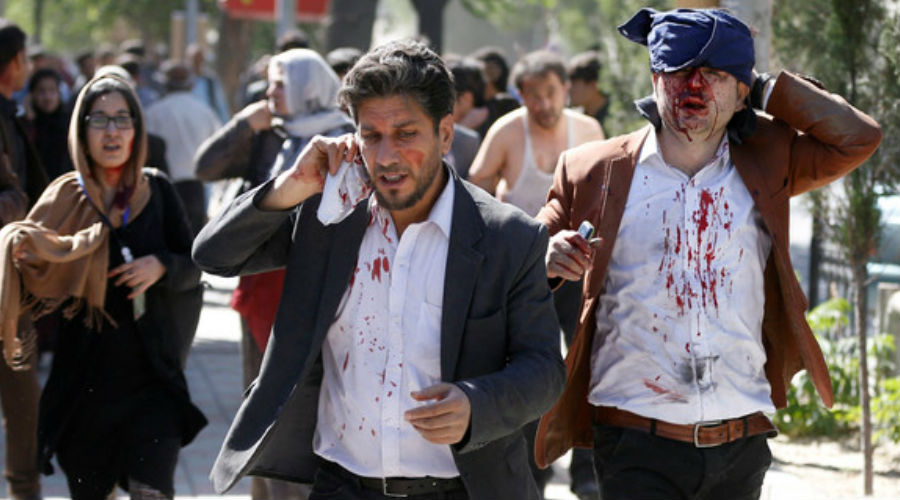Afghanistan appears to be heading into a new stage of security instability following the recent rise in terrorist attacks. After the most recent high-profile attack - which hit the diplomatic district in the capital Kabul on May 31, 2017 killing around 90 people and injuring 400 others- signs emerged about the trajectories and balances of power relations between terrorist organizations that sought to entrench their influence and expand their activity inside Afghanistan in the past.
That is to say, the fact that Kabul blamed the bombing on the Taliban-affiliated Haqqani network claiming it acted with the help of Pakistan's intelligence service, has not held other parties from blaming ISIS. Blaming the terror group was not only promoted by the fact that it recently sought to escalate its terrorist attacks inside Afghanistan - in response to a decline in its role in areas under its control in both Syria and Iraq- but also because the Kabul attack was carried out using mechanisms similar to those frequently used by ISIS.
Moreover, other parties have not excluded the possibility that the Taliban was involved in the attack. The assumption is based on the fact that the movement is keen on leveraging its influence as the major terrorist organization on the Afghan scene, due to its escalating rivalry with ISIS which succeeded in recruiting a number of Taliban commanders and elements over the past period.
Considerations
Views in favor of the assumption that the Haqqani network was responsible for the Kabul attack were based on a number of indications the most prominent of which was that the attack was not a conventional one. The huge bombing that hit the so-called green area in Kabul’s diplomatic district was one of the deadliest attacks causing the heaviest toll of dead and wounded since the Taliban was toppled following the 9/11 attacks in 2001.
The modus operandi of the attack indicates that the perpetrators possessed extensive capabilities and critical information that enabled them to breach security fortifications in the targeted area. However, several reports indicated that the attackers have not reached the primary target in the diplomatic district due to measures taken by Afghan security personnel.
Moreover, the Kabul bombing, according to this view, was maybe a message from the Haqqani network to the Afghan government. The message would be that the government’s execution of a group of Haqqani elements and commanders- including Anas Haqqani, son of the network’s founder- following court orders, has pushed the Haqqani network to escalate its terrorist attacks to an unprecedented level, particularly in light of the role that Anas had played in establishing and running the network before he was arrested by the Afghan government authorities several years ago.
These views also pointed out that there are more signs that the network was involved in the Kabul attack citing that other organizations denied responsibility although they have been recently keen on escalating their terrorist operations. These include the Taliban which began what it called the “spring offensive” targeting the Afghan army and police. One such attack struck an army base in Mazar-e Sharif on April 21, 2017, killing 135 soldiers and leading to the resignation of the Afghan Minister of Defense and the army Chief of Staff.
However, others views are that the Taliban’s keenness on denying responsibility for the bombing cannot exclude its possible involvement in the attack. That is because the movement is currently sending a message to both the Afghan government and other terrorist organizations such as ISIS. The message entails that it is capable of carrying out high-profile terrorist attacks despite having suffered recent heavy blows that killed a number of its senior commanders including Mullah Abdul Salam Akhund, commander of Taliban forces in Kunduz province who was also known as “Conqueror of Kunduz”, in a US drone attack on February 26, 2017.
Multiple Implications
The attack on the diplomatic district in Kabul may impose the following implications:
1- Intensifying confrontations between the Haqqani network and the government, in particular because President Mohammad Ashraf Ghani’s issued an order for the execution of 11 Taliban and Haqqani network prisoners, including Anas Haqqani, on June 1, 2017, only one day after the terrorist attack. Through such orders, the Afghan government seeks to contain internal resentment over security measures that could not, according to a number of reports, cut a long-standing series of terrorist attacks.
2- Widening tensions between Afghanistan and Pakistan, after Kabul accused Islamabad of supporting the Haqqani network which it blamed for the recent attack. The tensions would impose negative repercussions on recent efforts by Afghanistan and Pakistan to expand their security coordination. The two states were keen on holding meetings between their security officials on May 12, 2017 to discuss an agreement on enhancing military cooperation and adopt confidence-building measures after a cross-border shootout between Pakistani and Afghani border police that left several people dead earlier this month.
3- Increasing international interest in fighting terrorism in Afghanistan. This is mainly driven by terrorist organizations’ plans to intensify their attacks against the North Atlantic Treaty Organization’s forces deployed to Afghanistan in the coming period. This has prompted NATO to call for increasing non-combatant troops in Afghanistan to several thousands to contribute towards efforts to combat these organizations.
In conclusion, it is possibly safe to say that the Afghan government will now face no easy challenges, due to the recent escalation in terrorist attacks in several areas inside Afghanistan, or the widening rivalry between various terrorist organizations seeking to bring about a change to their balance of power to support their own interest. This would impose the need for adopting non-conventional measures, upgrading security cooperation with powers involved in the war on terrorism to address threats posed by these organizations in the coming period.


